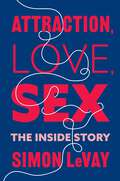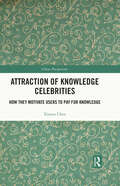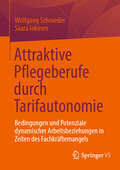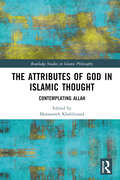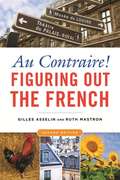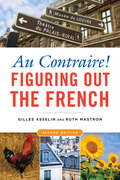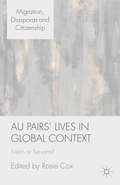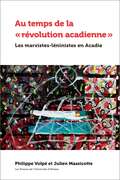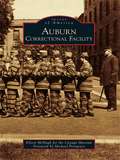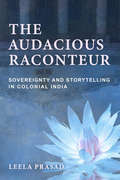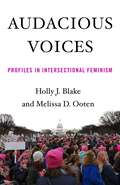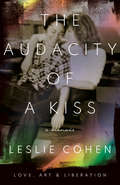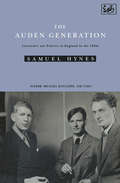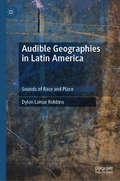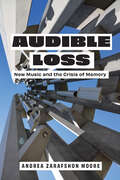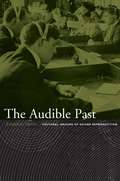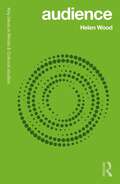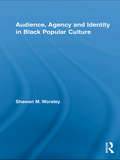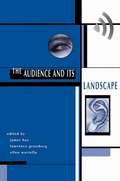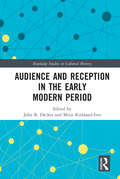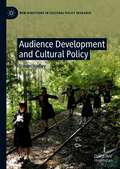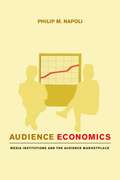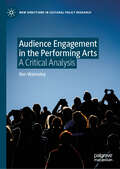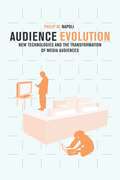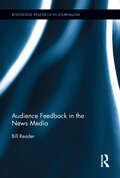- Table View
- List View
Attraction, Love, Sex: The Inside Story
by Simon LeVaySex, after hunger, may be the most powerful motivating force in our lives. It drives us to seek intimate contact with others and to form relationships that may be fleeting or lifelong, blissful or troubled. Yet many mysteries surround sex and sexuality: Why don’t we reproduce by virgin birth? Why does so much of our sexual behavior have nothing to do with reproduction? Why isn’t everyone heterosexual? How does the brain create sexual arousal? How do sexual kinks develop? Is porn harmful? What is the relationship between sex and love?In Attraction, Love, Sex, the renowned scholar Simon LeVay introduces readers to a memorable cast of researchers trying to answer these questions and many more. A biologist dredges a New Zealand lake for asexual mud snails. Psychologists measure whether eating a good meal changes a man’s idea of female beauty. Physiologists probe orifices with miniature toilet plungers and place lovers in brain scanners. Geneticists reconstruct the sex crimes of Genghis Khan. Neuroscientists create mice whose sexual behavior can be switched on and off. A zoologist traps and releases 260,000 voles and launches a new science of love.LeVay distills vast expertise on the biology and psychology of sex into an engaging and easy-to-understand survey with scientific acumen, a critical eye, and a sense of humor. This book reveals how scientists are unraveling the secrets of sex and, in the process, shattering many traditional ideas and prejudices.
Attraction of Knowledge Celebrities: How They Motivate Users to Pay for Knowledge (China Perspectives)
by Xiaoyu ChenThis book examines the phenomenon of knowledge celebrities, an emerging group of social media influencers who produce and sell knowledge products online. Its primary goal is to investigate the reasons and strategies behind their ability to attract users and persuade them to purchase knowledge products on digital platforms. With the increasing demand for high-quality content from online users, various platforms have emerged as pay-for-knowledge platforms, allowing knowledge celebrities to monetize their expertise. This book draws on theoretical frameworks from information science, communication and management to provide insights into this phenomenon and to examine the practices and individuals involved. Building on existing scholarship and analyzing case studies in China, this book presents the background, basic concepts and understanding of knowledge celebrities. It then explores the three key factors that contribute to the attractiveness of knowledge celebrities, as well as the motivations and mechanisms behind pay-for-knowledge practices. Finally, the book offers a glimpse into the future landscape of knowledge celebrities and pay-for-knowledge platforms. The book will be valuable to scholars, students, and practitioners in information, communication and media studies. In particular, it will appeal to those interested in topics such as knowledge celebrities, the creator economy and knowledge management.
Attraktive Pflegeberufe durch Tarifautonomie: Bedingungen und Potenziale dynamischer Arbeitsbeziehungen in Zeiten des Fachkräftemangels
by Wolfgang Schroeder Saara InkinenDeutschland leidet unter einem akuten Mangel an Pflegepersonal, insbesondere im Bereich der Altenpflege. Der bestehende „Pflegenotstand" ist nicht nur eine Belastung für die Versorgung älterer Menschen, sondern verschärft zugleich die belastenden Arbeitsbedingungen, den Mangel an Anerkennung sowie den Rationalisierungsdruck im Pflegealltag. Vor diesem Hintergrund wird in diesem Buch die Frage untersucht, ob und wie durch kollektive Selbstorganisation der Beschäftigten eine Verbesserung der Lage erreicht werden kann. Dabei werden neben den Präferenzen der Beschäftigten auch das Handeln der Gewerkschaften, der Arbeitgeber und des Staates in der Pflege analysiert. Das Besondere dieser Studie besteht darin, dass diese Fragen bereits einige Jahre zuvor mit dem gleichen methodischen Ansatz untersucht wurden.
The Attributes of God in Islamic Thought: Contemplating Allah (Routledge Studies in Islamic Philosophy)
by Mansooreh KhalilizandThe debate over Allah’s attribute—the “nature” and the inner articulation of Allah—is one of the focal debates in the intellectual history of Islam. This edited collection aims to highlight and examine some aspects of this debate in their original context, based on the relevant primary literature.By showing that even an apparently self-evident concept such as Allah, which lies at the heart of every reading of Islam, is highly ambiguous and polysemous, the chapters also emphasise the plurality that has always existed in Islamic thought. Through highlighting the philosophical and theological reflections on the concept of Allah, the results of this study challenge the juristic reading of Islam, in which Allah’s function consists mainly in providing a detailed plan for the human life and also rewarding or punishing the ones who deviates from it. The book also attempts to demonstrate the relevance and the actuality of the tradition and to stress its contemporaneity.This volume makes a significant part of the intellectual tradition of Islam accessible for students and scholars of Islamic theology, Islamic philosophy, Islamic studies and the like, as well as providing a secondary source for teaching on the debate in question.
Au Contraire!: Figuring Out the French
by Ruth Mastron Gilles AsselinWritten for anyone interacting with the French (tourists, businesspeople, international students, etc.), Au Contraire!, 2nd ed. offers a perceptive understanding of French cultural beliefs, assumptions, and attitudes-along with practical advice on building strong personal and professional relationships with the French. Friendship, politics, work, education, and romance are all addressed in this revised edition.
Au Contraire!: Figuring Out the French (Interact Ser.)
by Ruth Mastron Gilles AsselinThe French are famously enigmatic: fiercely independent yet deeply romantic,conservative yet avant-garde, rational yet emotional. What is it, exactly, that makes the French so... French? Written for anyone interacting with the French - tourists, businesspeople, international students, Francophiles - Au Contraire! offers a perceptive understanding of French cultural beliefs, assumptions and attitudes, along with practical advice on building strong personal and professional relationships with the French. Addressing issues like friendship, politics, work, education and romance, bilingual and bi cultural authors Asselin and Mastron draw upon their own experiences as consultants and trainers, as well as those of students and professionals, giving readers a complete - and compelling - look at French culture. This revised edition of Au Contraire! includes updated information about France's changing social and political climate, advice for succeeding as an expat, information about the French educational system, overviews of France's diverse regions - and more.
Au Pairs' Lives in Global Context: Sisters or Servants? (Migration, Diasporas and Citizenship)
by R. CoxFar from being the preserve of middle-class women from Northern Europe, au pairing is now booming worldwide. This collection, the first dedicated entirely to examining the lives of au pairs, traces their experiences across five continents showing how this form of domestic labour and childcare is thriving in the twenty-first century.
Au temps de la « révolution acadienne »: Les marxistes-léninistes en Acadie (Amérique française)
by Philippe Volpé Julien MassicottePartant d’une sociologie historique des mouvements marxistes-léninistes au sein des provinces maritimes pendant les années 1960-1980, cet ouvrage offre une interprétation et une contextualisation inédites des mouvements de gauche en Acadie. Les années 1970 constituent une décennie particulièrement agitée en ce qui a trait aux mobilisations sociales, politiques et culturelles en Acadie. À la suite des réformes mises en oeuvre par le gouvernement de Louis J. Robichaud au Nouveau-Brunswick et de la modernisation des institutions acadiennes au cours des années 1960, les années 1970 sont le théâtre d’idéologies et d’engagements concomitants menant plus avant le militantisme de la décennie précédente. C’est le moment où entrent en scène le Parti acadien, la revue L’Acayen et plusieurs organisations et associations ouvrières, féministes et étudiantes. C’est durant cette période que commencent à paraître en Acadie les premiers groupuscules se réclamant directement de Marx, de Lénine et de Mao, ou du communisme en général. Les auteurs de cet ouvrage ont voulu rendre compte, dans une analyse à la frontière de l’histoire et de la sociologie, de ce chapitre oublié du passé acadien récent. Au centre et en marge de différents événements et phénomènes sociaux, allant de la pauvreté aux conflits économiques, culturels et générationnels, en passant par le syndicalisme et de multiples mouvements de contestation, la présence des marxistes-léninistes dans les provinces maritimes s’est fait sentir discrètement, certes, mais de nombreuses façons. C’est cette histoire que Philippe Volpé et Julien Massicotte nous livrent dans une étude fouillée et passionnante de l’extrême-gauche en Acadie. Une coédition avec le Centre de recherche en civilisation canadienne-française. Publié en français
Auburn Correctional Facility
by Michael Pettigrass Eileen Mchugh Cayuga MuseumWhat is now called Auburn Correctional Facility has been open in Auburn since 1817, and it is the oldest continually operating prison in the country. Auburn's claim to being the preeminent American prison is bolstered by its many firsts. Auburn was the first prison in the world to house convicts in individual cells and the first prison in the country to employ a chaplain and put a matron in charge of the women prisoners. Auburn Prison developed the widely duplicated system of inmate management that became known as the Auburn System, a totally silent regimen of forced labor and complete control. Auburn was the first prison to separate mentally unstable inmates from the general population and was the site of the world's first use of the electric chair for capital punishment. The prison was at the front line of the prison reform movement in the early 20th century when Thomas Mott Osborne was voluntarily incarcerated and helped found the Mutual Welfare League in Auburn Prison in 1913.
The Audacious Raconteur: Sovereignty and Storytelling in Colonial India
by Leela PrasadCan a subject be sovereign in a hegemony? Can creativity be reined in by forces of empire? Studying closely the oral narrations and writings of four Indian authors in colonial India, The Audacious Raconteur argues that even the most hegemonic circumstances cannot suppress "audacious raconteurs": skilled storytellers who fashion narrative spaces that allow themselves to remain sovereign and beyond subjugation. By drawing attention to the vigorous orality, maverick use of photography, literary ventriloquism, and bilingualism in the narratives of these raconteurs, Leela Prasad shows how the ideological bulwark of colonialism—formed by concepts of colonial modernity, history, science, and native knowledge—is dismantled. Audacious raconteurs wrest back meanings of religion, culture, and history that are closer to their lived understandings. The figure of the audacious raconteur does not only hover in an archive but suffuses everyday life. Underlying these ideas, Prasad's personal interactions with the narrators' descendants give weight to her innovative argument that the audacious raconteur is a necessary ethical and artistic figure in human experience.
Audacious Voices: Profiles in Intersectional Feminism
by Holly Blake Melissa OotenInspiring and hopeful, Audacious Voices is a collection of twelve stories from alumnae/alumni of WILL*, a feminist model for education. Each author featured in this book is working, in their own distinct way, to make their communities more equitable—and their stories illustrate how different elements of the WILL* program influence and inspire them to act with such intentionality. Author-activist Courtney Martin writes in The New Better Off that the times we live in may break our hearts, but they don&’t have to break our spirit; it&’s that spirit that these stories capture, alongside the power of a feminist educational program that engenders such spirit. Emphasizing hope, empathy, resiliency, and solutions by showcasing the transformative power of inclusive leadership, advocacy, and mentorship, Audacious Voices reminds us that real change is possible, even in the current political climate.
The Audacity of a Kiss: Love, Art, and Liberation
by Leslie CohenRendered in bronze, covered in white lacquer, two women sit together on a park bench in Greenwich Village. One of the women touches the thigh of her partner as they gaze into each other’s eyes. The two women are part of George Segal’s iconic sculpture “Gay Liberation,” but these powerful symbols were modeled on real people: Leslie Cohen and her partner (now wife) Beth Suskin. In this evocative memoir, Cohen tells the story of a love that has lasted for over fifty years. Transporting the reader to the pivotal time when brave gay women and men carved out spaces where they could live and love freely, she recounts both her personal struggles and the accomplishments she achieved as part of New York’s gay and feminist communities. Foremost among these was her 1976 cofounding of the groundbreaking women’s nightclub Sahara, which played host to such luminaries as Betty Friedan, Gloria Steinem, Pat Benatar, Ntozake Shange, Rita Mae Brown, Adrienne Rich, Patti Smith, Bella Abzug, and Jane Fonda. The Audacity of a Kiss is a moving and inspiring tale of how love, art, and solidarity can overcome oppression.
The Auden Generation
by Samuel HynesThis is a study of a literary generation writing in a period of expanding fears and ever more urgent political and social crises. The pace of the time itself, the sense of time passing and an end approaching gave a special quality to the Thirties. The public world pressed insistently on the private world. For those who came of literary age - Auden, Day Lewis, MacNeice, Spender, Graham Greene, Isherwood and Orwell among them - writing became a form of action. In the process a generation discovered itself and found its own expression.
Audible Geographies in Latin America: Sounds of Race and Place
by Dylon Lamar RobbinsAudible Geographies in Latin America examines the audibility of place as a racialized phenomenon. It argues that place is not just a geographical or political notion, but also a sensorial one, shaped by the specific profile of the senses engaged through different media. Through a series of cases, the book examines racialized listening criteria and practices in the formation of ideas about place at exemplary moments between the 1890s and the 1960s. Through a discussion of Louis Moreau Gottschalk’s last concerts in Rio de Janeiro, and a contemporary sound installation involving telegraphs by Otávio Schipper and Sérgio Krakowski, Chapter 1 proposes a link between a sensorial economy and a political economy for which the racialized and commodified body serves as an essential feature of its operation. Chapter 2 analyzes resonance as a racialized concept through an examination of phonograph demonstrations in Rio de Janeiro and research on dancing manias and hypnosis in Salvador da Bahia in the 1890s. Chapter 3 studies voice and speech as racialized movements, informed by criminology and the proscriptive norms defining “white” Spanish in Cuba. Chapter 4 unpacks conflicting listening criteria for an optics of blackness in “national” sounds, developed according to a gendered set of premises that moved freely between diaspora and empire, national territory and the fraught politics of recorded versus performed music in the early 1930s. Chapter 5, in the context of Cuban Revolutionary cinema of the 1960s, explores the different facets of noise—both as a racialized and socially relevant sense of sound and as a feature and consequence of different reproduction and transmission technologies. Overall, the book argues that these and related instances reveal how sound and listening have played more prominent roles than previously acknowledged in place-making in the specific multi-ethnic, colonial contexts characterized by diasporic populations in Latin America and the Caribbean.
Audible Loss: New Music and the Crisis of Memory
by null Andrea Zarafshon MooreAn innovative and much-needed critical work on music and memorialization in relation to AIDS, 9/11, and anti-Black violence in AmericaMusic has long served as a powerful medium for communal mourning and remembrance in times of crisis. Audible Loss examines musical responses to three major crises in US society at the turn of the twenty-first century: the AIDS epidemic, the terrorist attacks of September 11, 2001, and the ongoing conditions of anti-Black violence.Analyzing a range of works written to commemorate these losses, Andrea Zarafshon Moore explores how contemporary classical music (aka “new music”) frames and narrates these crises, gives voice to grief, imagines other possibilities, and makes loss audible. These crises are read alongside one another to reveal the ways they are mutually imbricated, while also recognizing the sheer commemorative dominance of 9/11 in this century. Attending to broader debates and discourses through which commemoration is always filtered and the ways interpretive consensus has been sought and articulated in both musical and other memorial forms, Moore probes the conventional claims of commemoration, particularly those for the necessity of remembrance to “healing” and the prevention of future crises.Audible Loss concludes by reflecting on the limits of existing commemorative forms and the possibility, even necessity, of new ones. Taking the COVID-19 pandemic as a case study, it proposes that while memorials of all kinds may provide outlets for collective remembrance and even mourning, their power to forge a sense of collectivity is diminished as public discourse grows more fragmented. Deeply informed yet highly approachable, Audible Loss is a major contribution to the fields of music and memory studies and essential reading for anyone interested in memory culture in the United States today.
The Audible Past: Cultural Origins of Sound Reproduction
by Jonathan SterneThe Audible Past explores the cultural origins of sound reproduction. It describes a distinctive sound culture that gave birth to the sound recording and the transmission devices so ubiquitous in modern life. With an ear for the unexpected, scholar and musician Jonathan Sterne uses the technological and cultural precursors of telephony, phonography, and radio as an entry point into a history of sound in its own right. Sterne studies the constantly shifting boundary between phenomena organized as "sound" and "not sound. " In The Audible Past, this history crisscrosses the liminal regions between bodies and machines, originals and copies, nature and culture, and life and death. Blending cultural studies and the history of communication technology, Sterne follows modern sound technologies back through a historical labyrinth. Along the way, he encounters capitalists and inventors, musicians and philosophers, embalmers and grave robbers, doctors and patients, deaf children and their teachers, professionals and hobbyists, folklorists and tribal singers. The Audible Past tracks the connections between the history of sound and the defining features of modernity: from developments in medicine, physics, and philosophy to the tumultuous shifts of industrial capitalism, colonialism, urbanization, modern technology, and the rise of a new middle class. A provocative history of sound, The Audible Past challenges theoretical commonplaces such as the philosophical privilege of the speaking subject, the visual bias in theories of modernity, and static descriptions of nature. It will interest those in cultural studies, media and communication studies, the new musicology, and the history of technology.
Audience: Performance, Audience And Value (ISSN)
by Helen WoodThis accessible guide through audience studies’ histories outlines a contemporary Cultural Studies approach to audiences for the digital age. This book is not a survey of all existing audience research. Instead, its chapters survey parts of the field in order to draw some ‘through-lines’ from older traditions to contemporary debates, giving students a ‘way in’ to thinking about the current landscape from an ‘audience-sensitive’ perspective. In order to do this, the book utilises a series of verbs to organise and cut a path through audience research and register its ongoing relevance today. These verbs are: audience, anchor, mean, feel and work. The list is not exhaustive and the reader is invited to think about what verbs they would add or change throughout the book. Audience suggests renewing the importance of ‘form’ as a cultural process and in ‘circling-back’ to Cultural Studies’ ‘circuit of culture’, it proposes a modified framework for ‘the digital circuit’. Each chapter opens with a particular scenario for the reader to reflect upon and asks a specific question to help orient the account of research that is to come, especially for those new to Media and Cultural Studies and to audience studies.Written in an engaging and accessible style, this book is ideal for both students and researchers of Media and Cultural Studies.
Audience, Agency and Identity in Black Popular Culture (Studies in African American History and Culture)
by Shawan M. WorsleyAudience, Agency and Identity in Black Popular Culture analyses black cultural representations that appropriate anti-black stereotypes. Using examples from literature, media, and art, Worsley examines how these cultural products do not rework anti-black stereotypes into seemingly positive images. Rather, they present anti-black stereotypes in their original forms and encourage audiences not to ignore, but to explore them. Shifting critical commentary from a need to censor these questionable images, Worsley offers a complex consideration of the value of and problems with these alternative anti-racist strategies in light of stereotypes’ persistence. This book furthers our understanding of the historical circumstances that are influencing contemporary representations of black subjects that are purposefully derogatory and documents the consequences of these images.
The Audience and Its Landscape (Cultural Studies)
by James HayThis book offers a major reconceptualization of the term “audience,” including the landscape of a given audience—the situated and territorializing features of any way of seeing and defining the world. Given de Certeau's hypothesis that listening, watching, and reading all occur in places and result in produce transformed paths or spaces, the contributors to this landmark volume have provided innovative essays analyzing the transformations that take place in the geography between sender and receiver. The book acknowledges, in the face of conventional “discourse analysis,” the contextual features of discourse, to produce a complex and textured understanding of the concept of audience.The Audience and Its Landscape, presents the work of a vital cross-section of international scholars including Sweden's Karl Erik Rosengren, the UK's Jay G. Blumler and Roger Silverstone, Australia's Tony Bennett, Israel's Elihu Katz, Canada's Martin Allor, and the United States's Janice Radway, Byron Reeves, and John Fisk, to name a few. This book is truly groundbreaking in its depth and scope, and will speak to students of rhetoric, mass communication, cultural studies, anthropology, and sociology alike.
Audience and Reception in the Early Modern Period (Routledge Studies in Cultural History #109)
by John R. DeckerEarly modern audiences, readerships, and viewerships were not homogenous. Differences in status, education, language, wealth, and experience (to name only a few variables) could influence how a group of people, or a particular person, received and made sense of sermons, public proclamations, dramatic and musical performances, images, objects, and spaces. The ways in which each of these were framed and executed could have a serious impact on their relevance and effectiveness. The chapters in this volume explore the ways in which authors, poets, artists, preachers, theologians, playwrights, and performers took account of and encoded pluriform potential audiences, readers, and viewers in their works, and how these varied parties encountered and responded to these works. The contributors here investigate these complex interactions through a variety of critical and methodological lenses.
Audience Development and Cultural Policy (New Directions in Cultural Policy Research)
by Steven HadleyEncouraging more – and different – people to attend the arts remains a vital issue for the cultural sector. The question of who consumes culture, and why, is key to our understanding of the arts. This book examines the relationship of audience development to cultural policy and offers a ground-breaking perspective on how the practice of audience development is connected to ideas of democratic access to culture. Providing a detailed overview of arts marketing, audience development and cultural democracy, the book argues that the work of audience development has been profoundly misunderstood by the field of arts management. Drawing from a rich range of interviews with key individuals in the audience development field, the book argues for a re-conceptualisation of audience development as an ideological function of cultural policy. Of importance for students, academics and researchers working in arts management and cultural policy, the book is also vital reading for anyone working in the arts, cultural and heritage sectors with an interest in understanding how our relationship with the audience has been constructed.
Audience Economics: Media Institutions and the Audience Marketplace
by Philip M. NapoliFocusing on the electronic media—television, radio, and the Internet—Audience Economics bridges a substantial gap in the literature by providing an integrated framework for understanding the various businesses involved in generating and selling audiences to advertisers. Philip M. Napoli presents original research in order to answer several key questions: <P><P>How are audiences manufactured, valued, and sold? How do advertisers and media firms predict the behavior of audiences? How has the process of measuring audiences evolved over time? How and why do advertisers assign different values to segments of the media audience? How does audience economics shape media content?Examining the relationship between the four principal actors in the audience marketplace—advertisers, media firms, consumers, and audience measurement firms—Napoli explains the ways in which they interact with and mutually depend on each other. He also analyzes recent developments, such as the introduction of local people meters by Nielsen Media Research and the establishment and evolution of audience measurement systems for the Internet. A valuable resource for academics, students, policymakers, and media professionals, Audience Economics keeps pace with the rapid changes in media and audience-measurement technologies in order to provide a thorough understanding of the unique dynamics of the audience marketplace today.
Audience Engagement in the Performing Arts: A Critical Analysis (New Directions in Cultural Policy Research)
by Ben WalmsleyThis book explores the concept of audience engagement from a number of complementary perspectives, including cultural value, arts marketing, co-creation and digital engagement. It offers a critical review of the existing literature on audience research and engagement, and provides an overview of established and emerging methodologies deployed to undertake research with audiences. The book focusses on the performing arts, but draws from a rich diversity of academic fields to make the case for a radically interdisciplinary approach to audience research. The book’s underlying thesis is that at the heart of audience research there is a mutual exchange of value wherein audiences ideally play the role of strategic partners in the mission fulfilment of arts organisations. Illustrating how audiences have traditionally been side-lined, homogenised and vilified, it contends that the future paradigm of audience studies should be based on an engagement model, wherein audiences take their rightful place as subjects rather than objects of empirical research.
Audience Evolution: New Technologies and the Transformation of Media Audiences
by Philip M. NapoliToday's consumers have unprecedented choice in terms of the technologies and platforms that access, produce, and distribute media content. The development and overlap of television, the internet, and other media technologies is fragmenting and empowering media audiences more than ever. <P><P>Building on his award-winning book, Audience Economics, Philip M. Napoli maps the landscape of our current media environment and describes its challenge to traditional conceptions of the audience. He examines the redefinition of the industry-audience relationship by technologies that have moved the audience marketplace beyond traditional metrics. Media providers, advertisers, and audience measurement firms now deploy more sophisticated tools to gather and analyze audience information, focusing on factors rarely considered before, such as appreciation, recall, engagement, and behavior. Napoli explores the interplay between political and economic interests in the audience marketplace and their effect on audience evolution. He recounts the battles waged between stakeholders over the assessment of media audiences and their efforts to restrict the functionality of new technologies. As Napoli makes clear, the very meaning of the media audience continues to evolve in response to changing technological, economic, and political conditions.
Audience Feedback in the News Media (Routledge Research in Journalism)
by Bill ReaderAs long as there has been news media, there has been audience feedback. This book provides the first definitive history of the evolution of audience feedback, from the early newsbooks of the 16th century to the rough-and-tumble online forums of the modern age. In addition to tracing the historical development of audience feedback, the book considers how news media has changed its approach to accommodating audience participation, and explores how audience feedback can serve the needs of both individuals and collectives in democratic society. Reader writes from a position of authority, having worked as a "letters to the editor" editor and has written numerous research articles and professional essays on the topic over the past 15 years.
